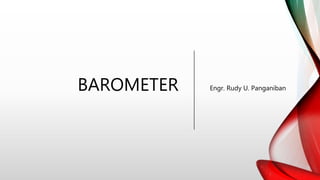
Barometer Instrumentation .pptx
- 1. BAROMETER Engr. Rudy U. Panganiban
- 2. OUTLINE 1. Facts about Barometer 2. Interesting Barometer Facts 3. Types of Barometer 4. Applications 5. How does Barometer predict weather
- 3. FACTS ABOUT BAROMETER A barometer is a meteorological tool used to measure atmospheric pressure. Measuring pressure in the atmosphere can help to forecast weather changes in the short term. The barometer was invented either by Gasparo Berti in the 1640s or Evangelista Torricelli in 1643. Barometers and pressure altimeters are essentially the same tool but barometers are kept stationary to measure atmospheric pressure and pressure altimeters are moved around from one place to another and matched to altitude. Atmospheric pressure it the weight of the air in the atmosphere and the barometer is able to measure this, which makes it one of a weather station's basic sensors and tools.
- 4. INTERESTING BAROMETER FACTS The two main types of barometers used for meteorology (weather science) are the aneroid barometer and the mercury barometer. A mercury barometer is usually a three foot high glass tube closed at one end with a reservoir of mercury open at the other. Atmospheric pressure changes the level of the mercury in the column. An aneroid barometer is a barometer without liquid, invented by Lucien Vidi in 1844. An aneroid cell in the barometer expands or contracts as a result of changes in external air pressure. The main types of barometers are water-based barometers, mercury barometers, vacuum pump oil barometers, aneroid barometers, and barographs. More unusual types of barometers include Collins Patent Table Barometer, Hooke's Otheometer, Ross Sympiesometer and the Shark Oil barometer, Some cell phones have aneroid barometers built in, such as the iPhone 6 smartphone, the Samsung Galaxy S3 to S6 models, and the Galaxy Nexus. The aneroid barometer does not use mercury.
- 5. Barometers have been used in weather forecasting dating back to the late 1800s. Altitude plays a role in the accuracy of a barometric reading. Because boats are at sea level they are the exception to using barometers in a fixed location. High pressure occurs when the air sinks to the earth more quickly than it is able to flow outward. With a mercury barometer this causes the mercury to rise higher and gives a reading of high pressure. Low pressure occurs when air rises from the earth more quickly than air flow is able to replace the lost air. With a mercury barometer the mercury drops to a lower level and gives a reading of low pressure. Although mercury barometers are accurate they contain mercury - which is not safe because it is a very poisonous form of liquid metal. The aneroid barometer was created to make barometers safer for use. Aneroid barometers are commonly used in small aircraft and in homes, as well as boats, or other places where mercury is not safe.
- 6. Barometric pressure can be reported in several different measurement units including in Hg(mercury) (inches of mercury - used mostly in the U.S.), mb (millibars - commonly used by meteorologists), Pa (pascals - worldwide SI unit of pressure), and Atm (atmospheres- pressure of air at sea level when temperature is 59 degrees Fahrenheit). When used for weather forecasting, decreasing air pressure usually is a sign of stormy, windy or rainy weather while slow rising air temperature is a sign of dry, calm weather.
- 7. • Types of the Barometer Its two main types are as follows: 1. Mercury Barometer 2. Aneroid Barometer
- 8. Mercury barometer This is the most popular barometer. It consists of the glass column with mercury and markings of inches on it. Its top end is closed and the bottom end is rested in the cup having mercury i.e. cistern. For more accuracy, these barometers are corrected for the ambient temperature gravity. This mercury is in use because of its density. Aneroid barometer This barometer comprises of fluid. It consists of the aneroid capsule which is a thin and flexible alloy based metal box This alloy is of beryllium and copper. For better expansion and contraction of the levers and springs of box happening due to change in the atmospheric outside the box, the box is tightly sealed.
- 9. APPLICATIONS Barometric pressure and the pressure tendency (the change of over time) have been used in weather forecasting since the late 19th century. When used in combination with wind observations, accurate short-term forecasts can be made. Simultaneous barometric readings from across a network of weather stations allow maps of air pressure to be produced, which were the first form of the modern weather map when created in the 19th century. Isobars, lines equal pressure, when drawn on such a map, give a contour map showing areas of high and low pressure. Localized high atmospheric pressure acts as a barrier to approaching weather systems, diverting their course. Atmospheric lift caused by low-level wind convergence into the surface brings clouds and sometimes precipitation. The larger the change in pressure, especially if more than 3.5 hPa (0.1 inHg), the greater the change in weather that can be expected. If the pressure drop is rapid, a low pressure system is approaching, and there is a greater chance of rain. Rapid pressure rises, such as in the wake of a cold front, are associated with improving weather conditions, such as clearing skies.
- 10. • How does Barometer Predict Weather The basic rules of thumb are: If the barometer measures low air pressure, the weather is bad; if high pressure, it is good. If pressure is falling, then the weather will get worse; if rising, better. The faster it is falling or rising, the faster and more the weather will change.